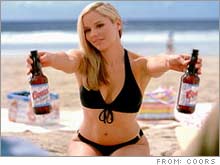|
What, no keg? Beer gets a makeover
As sales fall, Anheuser-Busch and others start a campaign to brew a 'finer' product image.
NEW YORK (CNNMoney.com) - As wine, vodka and whiskey grab market share from beer, leading brewers have crafted a new industrywide campaign that's aimed at "fighting back the enemy" by touting -- get this -- the finer aspects of beer. The effort is being spearheaded by beer industry leader Anheuser-Busch (Research), said Robert Lachky, the company's executive vice president of global industry development, in an interview with CNNMoney.com Thursday.
Lachky said Anheuser and its competitors are working with the Beer Institute, an industry trade group, to develop the campaign, which is expected to debut in February. Its official kickoff will be driven by a new Web site -- Herestobeer.com -- followed by brief spurts of TV ads which will direct viewers to the Web site for more information. "It's more of a grassroots effort," Lachky said. Beer has every right to be romanced
So what will the new face of beer look like? The ads will educate consumers about the "social value" of beer, Lachky said. Since beer is a less-concentrated form of alcohol, it's more appropriate for occasions other than sporting events and has "every right to be romanced as wine does," he said. The campaign will also "romance the product," or in other words, expose consumers to the brewing process and all that it entails. "There's more to beer than just knowing how to drink it," Lachky said. And just like wine makers have excelled at educating retailers and consumers about what foods go best with different wines, he said the beer industry will attempt to teach retailers about how to sell beer with various food groups. Because of the potential litigation risk, beer companies have shied away from openly advertising the "health" benefits of beer. However, a safer option is to get third parties, such as research groups, to conduct studies on the subject and discuss the role of beer in living a healthy lifestyle, Lachky said. "I don't think wine has anything over beer in terms of health benefits," he said. "But we won't say that. It's better that others study it and then we have an open dialogue about it." Will it work?
In a recent article published in Knowledge@Wharton, an online newsletter published by the Wharton School, associate professor of marketing Patricia Williams said beer companies shouldn't expect to reap immediate results from this effort. "It is a challenge in general to change an image, especially the image of an entire product category," Williams wrote. The beer industry faces an uphill battle in trying to "change the types of people who drink beer and the circumstances in which they consume it." Even though beer still leads in total alcohol consumption in the U.S. versus hard alcohol, the ongoing decline in beer sales is a worrisome trend for the industry, said Lachky. According to the Distilled Spirits Council of the United States (DISCUS), beer currently represents 51.4 percent of the total market for alcohol beverages, down from 53 percent in 2004. At the same time, market share for liquor like whiskey and vodka rose to 32 percent last year from 31.2 percent in 2004 and wine's market share also increased moderately to 16.6 percent in 2005 from 15.9 percent a year ago. Beer's market share has been trending lower since 2000. Wall Street isn't too happy about the situation. Investors have punished stocks of both Anheuser-Busch and Molson Coors. Anheuser (Research) shares have fallen more than 14 percent over the past 12 months while Molson Coors (Research) shares have declined 12 percent over the same period. Joel Whitaker, editor of trade publication Beverage News Daily, said beer companies have little choice but to shake things up any way that they can. "If I was in the beer business, I would be very concerned about how quickly I can turn things around," Whitaker said. Anheuser's Lachky argues that it's not too late. "We recognize that we have to become better at recapturing our market share," Lachky said. "Liquor companies are doing a good job at targeting beer drinkers and beer-drinking occasions. So we know who the enemy is and we have to do something about it." "But you have to put it in perspective. Beer is coming off its all-time highs while hard alcohol sales are coming off their all-time lows," Lachky said. "[Nevertheless], you're concerned about the future, about not letting this trend become a runaway train." Trading up
"The big difference between beer and spirits is that spirits like vodka and Scotch offer consumers a wide range of flavors and mixable options and you can buy them in a range of price points," said DISCUS' chief economist David Ozgo. Liquor and wine sales are growing at the expense of the mass-market beer brands also because consumers continue to "trade up" in alcohol beverages. "Spirits are perceived as affordable luxury," said Ozgo. "People are more careful with their spending today. Maybe they can't buy a $40,000 BMW but they're willing to buy a good $60 to $70 bottle of Scotch. You don't get that kind of trading-up feeling with beer." Ozgo said he's not worried about beer's image-enhancing efforts. "Imitation is the best form of flattery," he said. Miller Brewing and Coors could not immediately be reached for comment. ------------------------------------- To read about a beer ad that backfired with an airline, click here.
For more on the food and beverage sector, click here. |
|

